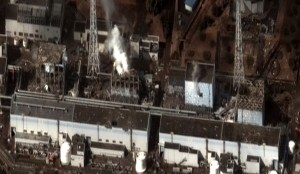
A satellite image of the damage at the Fukushima Daiichi nuclear power plant. (DigitalGlobe)
Two weeks after announcing the meltdown of fuel inside Fukushima’s No. 1 reactor, Tokyo Electric Power Company (TEPCO) has said there have very likely been partial meltdowns at the other two reactors that were operating when the crisis began on March 11 as well. A spokesman for TEPCO, Japan’s largest power company that has come under fire for its management of the crippled plant, said fuel rods at reactor No. 3 started melting March 13, two days after the 9.0 earthquake and ensuing tsunami struck the plant. Fuel rods at No. 2 probably started melting a day later, on March 14.
When the nuclear plant entered its state of emergency, the fuel rods inside these reactors began to melt from their upright position and slump down to the bottom of their containers, or pressure vessels, which are designed to keep them sealed up and isolated. That’s a problem because the nuclear fuel in a state of meltdown can, in the worst-case scenario, burn through its container and the plant infrastructure to leak into the ground around the facility. That, as Eben wrote here last week, is known as a ‘China Syndrome,’ and that’s what we want to avoid.
Fortunately, it appears for now we have dodged that bullet, and the not-great-but-not-apocalyptic news du jour is that the meltdowns at Nos. 2 and 3 are not as bad as what occurred at No. 1. About 35% of the rods at 2 and 30% of the rods at 3 were damaged, compared to a near total meltdown at 1. A TEPCO spokesman said on Monday that while those melted fuel rods inside 2 and 3 are still sitting at the bottom of their containment vessels, they are covered in water and stable, and damage to the vessels is “limited.” The situation at No. 1 is the more critical: the fact that water levels inside the vessel are believed to be low indicates the slumped fuel may have permeated the vessel, creating holes through which contaminated water may be leaking into the plant.
Minimizing the damage to the nuclear fuel rods inside the damaged reactor buildings has been the highest priority of TEPCO and the Japanese government since this crisis began to unfold more than two months ago. When the earthquake and tsunami wiped out the main electricity, generators, and backup battery systems at the plant designed to keep the cooling reactors’ cooling systems online, the race to find ways to keep the fuel cool was one. Some tactics – like having helicopters attempt (and mostly fail) to dump water over a reactor from the air – were designed more for PR than for practicality.
But in general, pouring water into the reactor cores has done what it’s supposed to. Temperatures inside the reactors are still too high to stop cooling them, but they are stable enough that fuel is no longer melting. The highest levels of radiation were released into the atmosphere in the early days, too, when at least two and possibly three hydrogen explosions, the result of the building up of heat and steam inside the cores, occurred in the reactor buildings, releasing radioactive material into the atmosphere. It was also during those first days after the disaster that TEPCO, at the insistence of Kan’s government, opened a vent in reactor 1 to relieve building pressure inside the building and prevent an explosion. (TEPCO hesitated to do so because the subsequent release of radiation into the atmosphere would push this crisis into Chernobyl territory. Too late.)
So why does the bad news from Fukushima keep coming? The utility says it is only starting to understand what it’s dealing with. The problem with a nuclear accident is that the damage gets done early, and fast. Even after the makeshift cooling system started to work, TEPCO knew there was damage to the fuel inside the reactors, but, they say, it wasn’t until radiation inside the reactor buildings dropped to safe enough levels for workers to go in and take measurements that the company could start to ascertain the problem. Some have argued that the release of the information was timed to have the least impact, now that life in Japan has started to get back to normalcy. “The situation will gradually be getting better,” says Dr. Bing Luk, TITLE TK. “As long as they keep the system cool, then it will just stay as is. In a few years, maybe they can start thinking about retrieving some of the fuel rods.”
That won’t be happening anytime soon. If the fuel rods were intact, Luk says the standard machinery used to handle them could go in, pluck them out of the containment vessels and stick them in the spent fuel pools where fuel rods go to die. But as we’ve established, they’re not intact, so instead TEPCO will have to leave the rods in situ while they lose potency. “If you can give them more time, the material will become less hot — both in terms of temperature and radioactivity,” Luk explains. Enter TEPCO’s plan to build a containment structure around the plant by the end of the year. The structure, which would be a precursor to a more permanent one, would contain the low levels of radiation that are still leaking from the plant while the figure out how to get the melted fuel out of the reactors.
For now, barring any significant discovery of a breach in one of the vessels or a major leak into the environment, the discouraging news trickling out of the plant doesn’t mean things are actively getting worse. It just means we’re finding out how bad they are.


